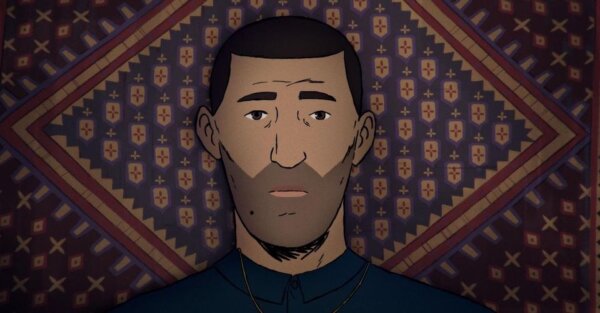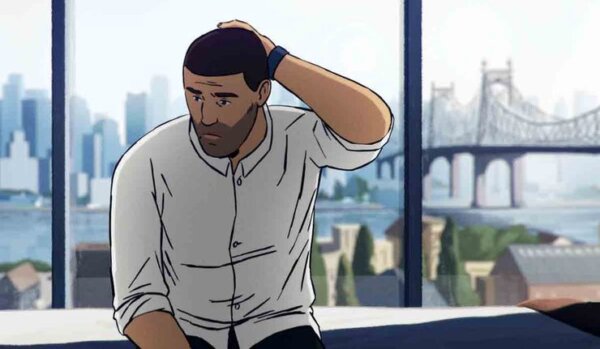Flee – Review
In the past year or so many have lamented the world of feature animation disappearing from theatres and heading direct to streaming services. To this end it would appear on a surface level that feature animation is destined to become filler for the algorithm to chew up and spit out on a digital whim. In reality, if we tilt our heads away from the noise of the American family feature market those willing to look beyond the multiplex will find an animated feature market that caters for all audiences and delivers stories and stylings that prove to anyone dull enough to state it, that animation is its own art form and can deliver powerful work in any genre. This market has always been here and Director Jonas Pohur Rasmussen is the latest who has seen the potential in animation and used it to create his latest documentary feature film FLEE, which is currently screening in cinemas in the UK.
FLEE tells the story of Amin, a man on the verge of marriage to his partner Jasper which compels him to detail his hidden past as an Afghan refugee for the first time. This is a true story and with animation Rasmussen has managed to preserve the anonymity of his childhood friend and recreate the richly detailed life that Amin has lived to turn Amins journey into a cinematic story.
The film is told in flashback by Amin, who takes us back to Afghanistan in the early 1980’s where as a carefree child he would dance in the street with his walkman, comb his sisters hair or admire, with some guilt, the movies and posters of Jean-Claude Van Damme. Afghanistan is often used in animated feature such as this. Since Nora Twomey’s The Breadwinner in 2017 the country has been returned to in The Swallows of Kabul (2019) and more recently My Sunny Maad (2021). This isn’t to point out that FLEE or any of the others lack originality, more to point out that each film takes us to the troubled country in a way in which modern governmental restrictions might not allow. Through animation we can be transported to any time and place and in FLEE we enter a country that no longer exists, a more liberal country where a young boy can wear his sisters dress and dance in the streets to 80’s pop
As Amins country changes, his life changes too and there is a creeping inevitability to what is to come, though we know his ultimate destination as a well to do academic looking to settle down with his husband, the twists and turns of his asylum journey are all to real.

As the colour palette changes from the warm and safe tones of childhood in Afghanistan to the harsh, cold tones of asylum in Russia we are reminded of the directors masterful blend of animation and documentary as sparingly he uses live action footage as he peppers news and stock footage throughout, grounding us in reality enough to remind us that, though a recreation, this is a true story and these characters are not mere drawings, but living and breathing individuals that have experienced unspeakable hardship.
The hardship is not sugar coated. We witness the reality of living under the vodka soaked and often violent whim Russian state police, difficult decisions and traumatic asylum attempts as his sisters flee to safety. The inescapable situation is made all the more real by a relentless pace and offers glimpses at the daily terror of life as an asylum seeker and the desperate measures they have to take just to survive.
There is a claustrophobia created by the storytelling and used to good effect. We accompany Amin as opposed to watch his journey and so are with him and his family alongside corrupt and violent state police, gun toting traffickers, sinking cargo ships and every life or death situation that has to be made along the way. The harshness of the situation often bites as you will Amin and his family to persevere and succeed. There is a moment when Amin is on a boat full of fellow asylum seekers, looking to escape to Norway. The boat pulls up in the fog alongside a cruise ship to the joy of the passengers. This euphoria is quickly dissolved as the rich passengers on the cruise ship stare down on the tiny boat and it is announced that yet again that Amins journey must return to square one. When you feel that the situation will present you with a hopeful outcome it is snatched away. The suffocating pace is occasionally relieved as we visit moments from Anims modern life that link to the past as he tries to build his future with Jasper, though his past still casts a long shadow.

There were moments where I believed that the film was perhaps concentrating on the hardship too much, and that Amins sexuality had been added as a bit of superfluous texture to the film. There is however a tender end to this thread that concludes the flashbacks and acknowledges his sexuality. There is a beauty in the delivery of this and a reminder that after a deeply dehumanising journey that humanity still exists where we wish to find it.
Though many lament the fact that multiplex films are disappearing from cinemas, they may find no comfort in viewing this film. Though FLEE has just as much right to live on the big screen as the latest blockbuster it is a film that will challenge your emotions and reminds us that filmmaking isn’t just about making us feel warm and fuzzy. It can be about revealing hardships, about empathy and reminds us of the fragile balance of our place in society.
FLEE achieves all of these things and more.
FLEE is screening in cinemas across the UK now.

